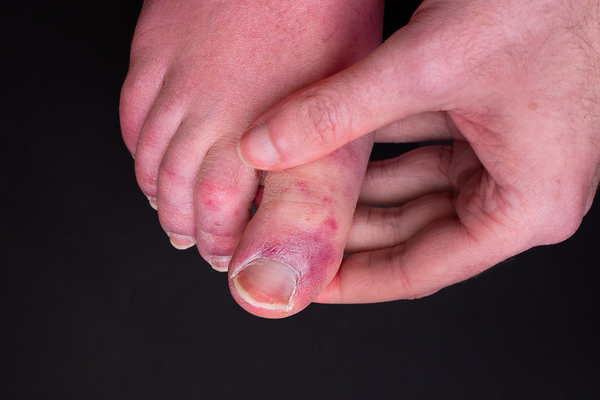Since the pandemic began, some unusual symptoms have been linked with COVID-19. One of the most surprising is so-called “COVID toes”—a red or purplish rash or raised bumps typically on the tips of the toes. Experts have been unsure about whether COVID toes were actually linked to COVID-19 (or just some odd coincidence in some patients), and it hasn’t made any official list of COVID symptoms. But now, new research has strengthened the connection.
Health magazine reports that a small study, published on October 5 in the British Journal of Dermatology, analyzed 63 people with redness and swelling in their hands and toes, also known as chilblain-like lesions (after chilblains, a condition triggered by exposure to extreme cold temperatures). Fifty of those study participants had COVID toes, according to the researchers; all had tested positive for the virus. Thirteen of the study subjects were determined to have chilblains lesions.
The researchers found that both groups developed their symptoms as a result of an immune response containing high levels of certain auto-antibodies, especially an antibody called type I interferon. The endothelial cells, which make up the thin membrane that lines the inside of blood vessels, also seemed to play a role.
The language in the study is pretty medical jargon-y, but dermatologist Ife J. Rodney, MD, founding director of Eternal Dermatology Aesthetics and a professor at Howard University, breaks it down. “As with other viral infections, your body mounts an immune response in an attempt to fight off the COVID-19 virus,” she said in an interview with Health. “This immune response causes inflammation throughout your body that can present in a variety of different ways on the skin.” Interferon is a protein involved in inflammation, she adds.
That can lead to rashes that may feature flat, red spots, and some may be itchy or even painful, Dr. Rodney says. “In COVID toes, the inflammation also damages small blood vessels in the toes, leading to a reddish-purple discoloration of your skin.” That discoloration is usually seen in a condition called chilblains, she says. “We are unsure why the COVID rash takes on this specific presentation, as it does not seem to be more common in the wintertime or related to cold exposure,” she adds.
It’s not entirely clear, but “the reason why some people experience these symptoms more than others is likely because of differences in the degree to which one person’s immune system reacts versus another person’s,” Joshua Zeichner, MD, director of Cosmetic & Clinical Research in Dermatology at Mount Sinai Hospital in New York City. Keep this in mind, though, per infectious disease expert Amesh A. Adalja, MD, a senior scholar at the Johns Hopkins Center for Health Security in Maryland: “COVID toes are not a very common phenomenon, but do occur and should prompt medical evaluation.”
Nazanin Saedi, MD, dermatologist at Thomas Jefferson University in Philadelphia, points out that “COVID toes” have mainly surfaced in children and young adults. “Children and young adults have stronger immune systems and they have a strong local response.” And Ted Lain, MD, board-certified dermatologist and chief medical officer at Sanova Dermatology, states that “the scientific community hypothesizes that ‘COVID toes’ are possibly a sign of a robust immune response, and also could be why younger people tend to have a more mild course of infection than adults.”
What should you do if you suspect you’ve got “COVID toes?” If you happen to show signs of “COVID Toes” but don’t have any other symptoms of the virus, Dr. Rodney says you shouldn’t automatically assume that you have COVID-19. Chilblains-like lesions can be seen with other conditions, she points out, so it’s best to get tested for COVID-19 and take things from there.
If you do, in fact, have “COVID toes,” Dr. Zeichner says you can expect that the rash will last for about two weeks, although it could be longer. “Less commonly, the rash has been reported to last for months, even after the initial COVID infection has resolved,” he says. As for taking care of your toes, Dr. Rodney recommends keeping them “warm and dry.” Otherwise, you may need to simply wait until the discoloration goes away.
—
Photo Credit: Chris Curry / Shutterstock.com
